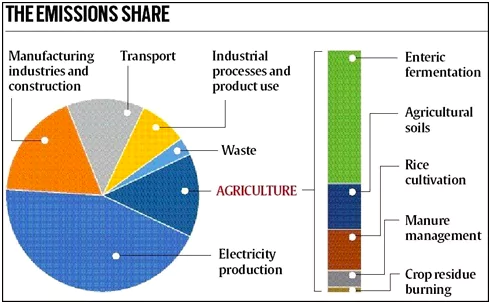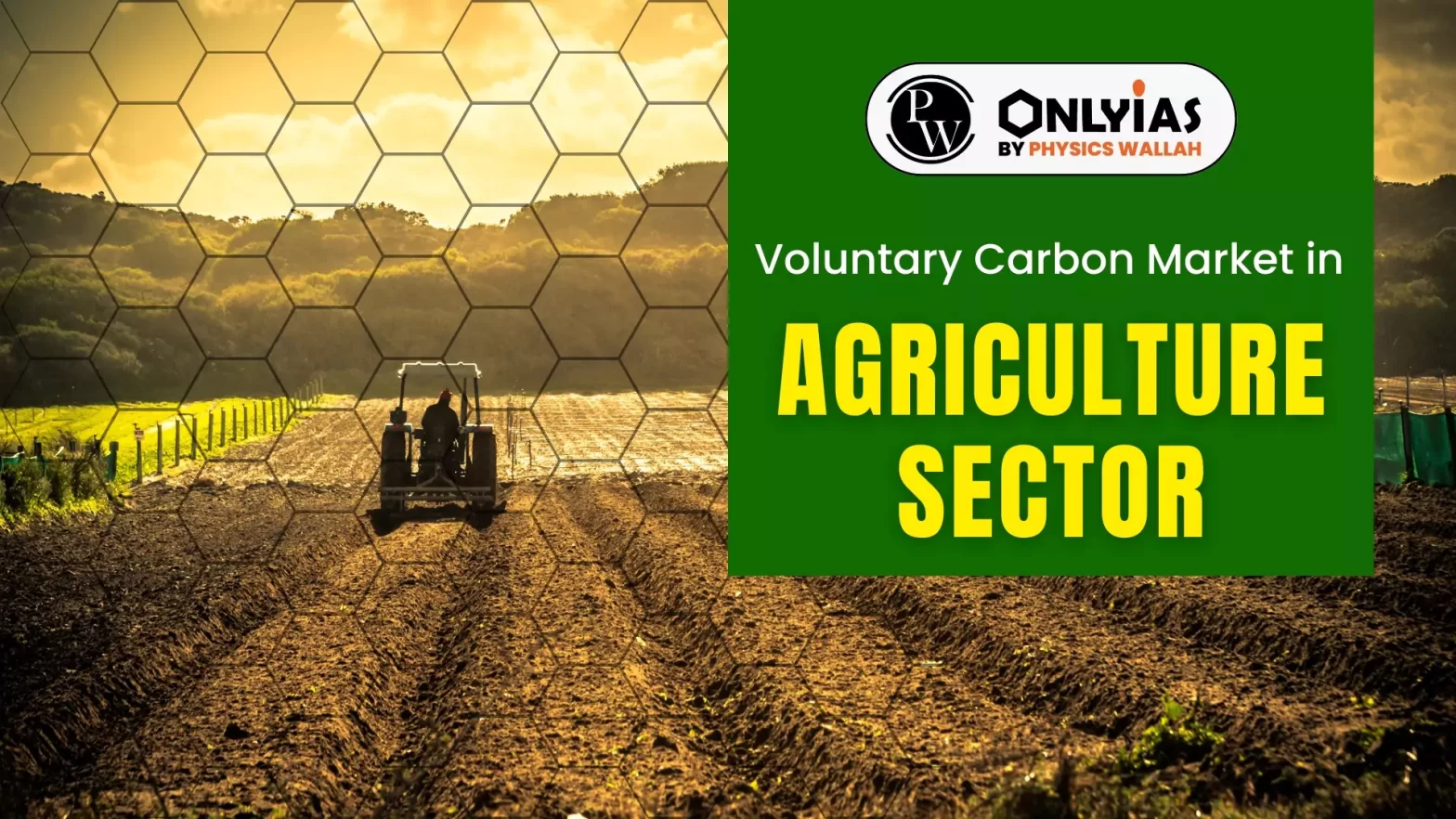Context:
This article is based on the news “Launch of Framework for Voluntary Carbon Market in Agriculture Sector and Accreditation Protocol of Agroforestry Nurseries” which was published in the PIB. The Union Minister of Agriculture & Farmers’ Welfare and Tribal Affairs launched the Framework for Voluntary Carbon Market in Agriculture Sector and Accreditation Protocol of Agroforestry Nurseries.
Govt Launches Framework For Voluntary Carbon Market in Agriculture Sector
- Availing Carbon Credit Benefits: The framework will encourage small and medium farmers to avail of carbon credit benefits.
- Enhancing Sustainable Agriculture: Introducing farmers to the carbon market will benefit them and accelerate the adoption of environment-friendly agricultural practices.
Agroforestry
- Agroforestry is a land use system that integrates trees and shrubs on farmlands and rural landscapes to enhance productivity, profitability, diversity and ecosystem sustainability.
National Agroforestry Policy
- It aims to encourage and expand tree plantation in complementarity and integrated manner with crops and livestock to improve rural households’ productivity, employment, income and livelihoods.
|
- Accreditation Protocol of Agroforestry Nurseries: It will strengthen the institutional arrangements for large-scale planting material production and certification to promote agroforestry in the country.
- Quality planting material can provide assured returns and the objectives and goals of the National Agroforestry Policy can be achieved.
About Carbon Market
- Genesis: The idea of a carbon market first emerged from the Kyoto Protocol in 1997 which operationalized the United Nations Framework Convention on Climate Change by committing countries to limit and reduce greenhouse gases (GHG) emissions.
- Types of Carbon Markets: There are broadly two types of carbon markets: compliance and voluntary.
- Compliance markets are created as a result of any national, regional and/or international policy or regulatory requirement.
- Voluntary carbon markets refer to the issuance, buying and selling of carbon credits, voluntarily.
Voluntary Carbon Market in Agricultural Sector
- About: Carbon credits, generated by adopting sustainable agricultural practices are sold in the global voluntary carbon market (VCM). Corporations can purchase these credits to offset their own carbon emissions.
- Carbon credits are payments for implementing climate-friendly practices that reduce carbon emissions.
Need for Carbon Market in Agriculture Sector

- Huge Carbon Emissions from Agriculture:
- The Agricultural sector accounts for 18% of India’s cumulative GHG emissions, and consumes more than 50% of the country’s freshwater resources.
- It contributes to 73 per cent of the country’s methane emissions.
- India has not signed the recent EU-US pledge to slash methane emissions by 30 per cent by 2030 despite being the world’s third-largest emitter of methane.
- Impact of Nitrogen fertiliser Use: Agricultural soils are the national inventory’s largest single source of nitrous oxide (N2O) emissions.
- Nitrous oxide emissions from the use of nitrogen fertiliser increased by approximately 358 per cent from 1980-81 to 2014-15, growing at a statistically significant rate of 5,100 tonnes per year.
- Greenhouse Gases (GHG) Emissions from Excess Buffer Stocks: Rice stocks with the Food Corporation of India (FCI) are seven times the buffer norms for rice, which store large amounts of GHG.
- As per the national GHG inventory, rice cultivation is the third highest source (17.5 per cent) of GHG emissions in Indian agriculture after enteric fermentation (54.6 per cent) and fertiliser use (19 per cent).
- Paddy fields are anthropogenic sources of atmospheric nitrous oxide and methane, which are 273 and 80-83 times more powerful than carbon dioxide in driving temperature increase in 20 years’ (Sixth Assessment Report IPCC 2021)
- Enteric fermentation is a part of the digestive process in ruminant animals such as cattle, sheep, and buffalo which produces large amounts of methane, which is a potent greenhouse gas.
- Water Intensive: Paddy fields require about 4,000 cubic metres of water per tonne of rice for irrigation.
- The surplus stocks of 46 million metric tons of rice contain approximately 92 billion cubic metres of water and 260 million metric tons of carbon dioxide equivalent.
- Skewed Distribution of Agricultural research, development, education and extension (ARDE): The shares for animal husbandry, dairy development, and fisheries sectors in ARDE have decreased from 11 per cent to 8 per cent despite that 54 per cent of the GHG emissions within agriculture come from the livestock sector.
- Climate Change: With the increasing impacts of climate change, farmers face various issues like rising temperatures, water scarcity, and volatile market conditions.
- The carbon market can help mitigate climate change through carbon sequestration, improved soil health resulting in increased crop yields and water retention, biodiversity conservation, and sustainable land use.
- Monetizing Sequestered Carbon: The creation of a carbon market will help monetise the carbon sequestered in agriculture and agroforestry systems and facilitate its transaction like any other commodity.
- Farmers adopting sustainable farming practices can generate income by selling carbon credits and improving soil health, crop yield, land productivity, and profitability.
- In India, the market price of one agriculture-based carbon credit is approximately ₹725.
- A farmer can generate 4 to 12 carbon credits per hectare depending on the type of improved farming practices adopted and thus can earn additional income of ₹3,000-9000 per hectare.
- Backbone of Indian Economy: 54.6% of the country’s workforce is engaged in agriculture and allied sectors’ activities.
- The share of the agriculture sector in GDP is 18.6%, while the sown area is 139.3 million hectares, out of the country’s total geographical area.
Agricultural Carbon Credits
- Carbon credits can be generated in various ways.
- Soils as large carbon sinks: Crops take in carbon dioxide from the air and fix carbon in the soil which is released back into the atmosphere when fields are ploughed to grow the next crop.
- Zero tillage practices help store organic carbon in the soil, making the soil healthier and reducing the use of nutrients.
- Lower use of nutrients like urea and farm machinery saves energy and fertilisers using natural gas as a feedstock during manufacturing.
- Lower use of irrigation water also leads to energy savings since diesel or electric pumps usually pump water into fields.
- Sustainable practices include optimising water usage, adopting precision farming technology to minimise inputs, reducing greenhouse gas emissions, and improving soil fertility.
- Techniques such as managing crop residue in situ, optimising water usage in rice cultivation, employing farm mechanisation, drones, and satellite imaging can enhance productivity, prevent crop losses, and provide real-time insights for better land management.
- Soil wellness programs focused on enhancing soil organic carbon content, practices that mitigate carbon emissions while promoting carbon capture, and water optimization measures using bio-stimulants or drip irrigation systems.
Status of Voluntary Carbon Market
- Rapid Expansion: The global voluntary carbon market has been expanding fast due to the increasing demand for carbon credits from business organisations to meet their obligations to climate change mitigation.
- As per the 2022 Report of the Ecosystem Marketplace, about 500 million carbon credits, valued at $1.98 billion, were traded globally in the voluntary carbon market in 2021.
- However, the share of agriculture-based carbon credits was only one million worth $8.7 million.
|
Challenges Related to Carbon Market in Agriculture Sector
- Quantification: The biggest challenge is quantifying and verifying the additional carbon retained in the soil due to adopting farming practices.
- Trade-off between Additional Revenue and Crop yield: A farmer will adopt a carbon reduction practice if the revenue from the sale of carbon credits would compensate for the loss in crop yield due to its adoption.
- Such a trade-off may be a disincentive to the large-scale adoption of carbon abatement practices.
- Lack of awareness among farmers: Farming communities lack awareness of the environmental, social, and economic benefits of carbon abatement practices and carbon markets due to the nascent stage of the market.
- Lengthy cash incentive Process: Receipt of cash incentives for listed projects can take eight to 12 months for farmers and FPOs/nonprofits. This delay can be burdensome for farmers.
- Small and Marginal landholdings: In India, agriculture is dominated by small landholdings, which usually differ in their cropping pattern and the adoption of carbon abatement farm practices.
- Of the total 146 million landholdings, over 86 per cent are less than two hectares in size, and the amount of carbon credits received may not be sufficient for them to adopt regenerative agriculture practices.
- Reaching out to such a huge number of smallholders means higher administrative and transaction costs for buyers of the carbon credits.
Government Measures to Promote Carbon Market in Agriculture Sector
- Energy Conservation (Amendment) Act, 2022: It has been enacted in India to develop domestic carbon markets, avoid carbon debt risks, and position the country as the world’s largest exporter of carbon credits.
- An Agroforestry project in collaboration with The Energy and Resource Institute (TERI) was initiated by the Uttar Pradesh Government in April 2023.
- The project aims to integrate nature-based systems into agriculture, leveraging carbon sequestration to mitigate climate change and generate additional income opportunities for farmers.
Way Forward to Promote Carbon Market in Agriculture Sector
- Standardisation of Quantification Method: A transparent process of quantifying and verifying additional carbon generated by different farm practices needs to be evolved.
- Artificial intelligence and remote sensing will help assess the quantum of sequestered carbon and provide real-time data for more accurate estimation of carbon sequestration.
- Collaborations with research institutions and carbon verifiers can help develop standardised protocols and guidelines, simplifying the measurement and verification process.
- Streamlining Regulatory Network: Streamlining the regulatory framework, minimising transaction costs, and creating incentives and subsidies for sustainable farming practices and carbon sequestration can stimulate demand for carbon credits.
- The regulatory framework should provide clear guidelines and support for farmers and other stakeholders.
- Collective Action: Selling carbon credits in the voluntary carbon market can be difficult for individual farmers.
- Collaboration with Agro-tech Companies: They can facilitate their participation in voluntary carbon markets.
- Considering the projected 15-fold increase in demand for carbon credits by 2030, agritech companies should equip farmers with the necessary tools and facilitate the acquisition and sale of carbon credits.
- A few agro-tech companies, for example, Boomitra and Nurture organise farmers through intermediaries to facilitate their participation in voluntary carbon markets.
- Awareness Creation: Encouraging widespread adoption of sustainable practices requires grassroots-level initiatives that educate farmers about the benefits of sustainable farming, and facilitate knowledge sharing within communities.
- Educational programs, extension services, workshops, and training sessions can be organised to inform farmers about sustainable farming practices, carbon sequestration, and the potential monetization of carbon credits.
- Collaboration with FPOs and cooperatives can facilitate awareness and enable individual farmers to participate in carbon markets collectively.
- Focusing on ARDE: Research at ICRIER indicates that investing in agri-R&D yields much greater returns (11.2) compared to every rupee spent on say the fertiliser subsidy (0.88), power subsidy (0.79), education (0.97), or roads (1.10).
- Thus, increased emphasis on ARDE can help achieve higher agricultural production despite climate change.
- Reorienting Agriculture Policies: Although paddy cultivation has helped India achieve food security, it has over-exploited the groundwater resource, particularly in the northwest and some parts of south India.
- There is a need to revisit policies of subsidising power and fertilisers, MSP and procurement and reorient them towards minimising GHG emissions.
- Farmer groups and the private sector can reward farmers for switching from carbon-intensive crops to low-carbon-intensive crops or improving farming practices in rice systems to lower GHG emissions.
Conclusion
- Adopting a 3F Framework by prioritising Facilitation (of education and training to farmers), Fostering collective efforts and knowledge sharing, and Framing supportive policies and regulations will enable the agriculture sector to make substantial contributions to India’s climate goals while ensuring the well-being of farmers and rural communities.
![]() 30 Jan 2024
30 Jan 2024


